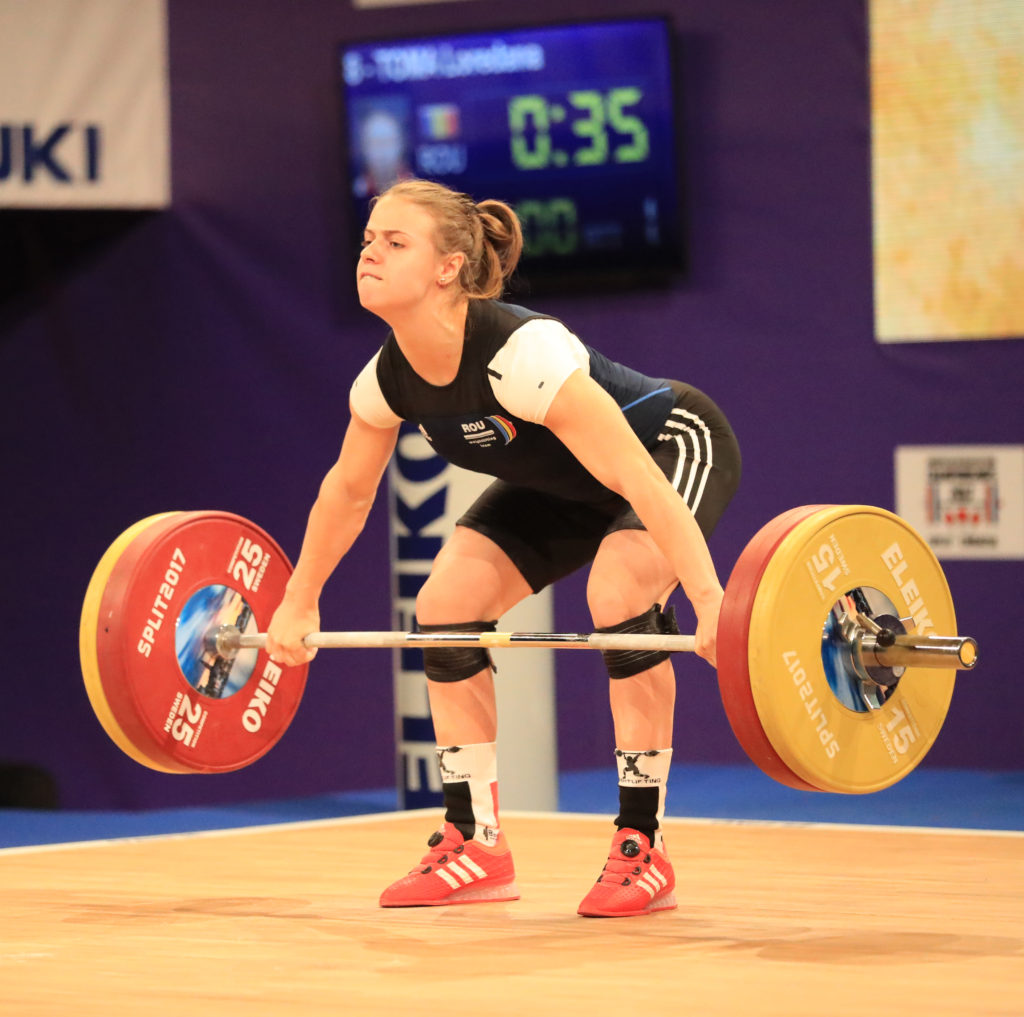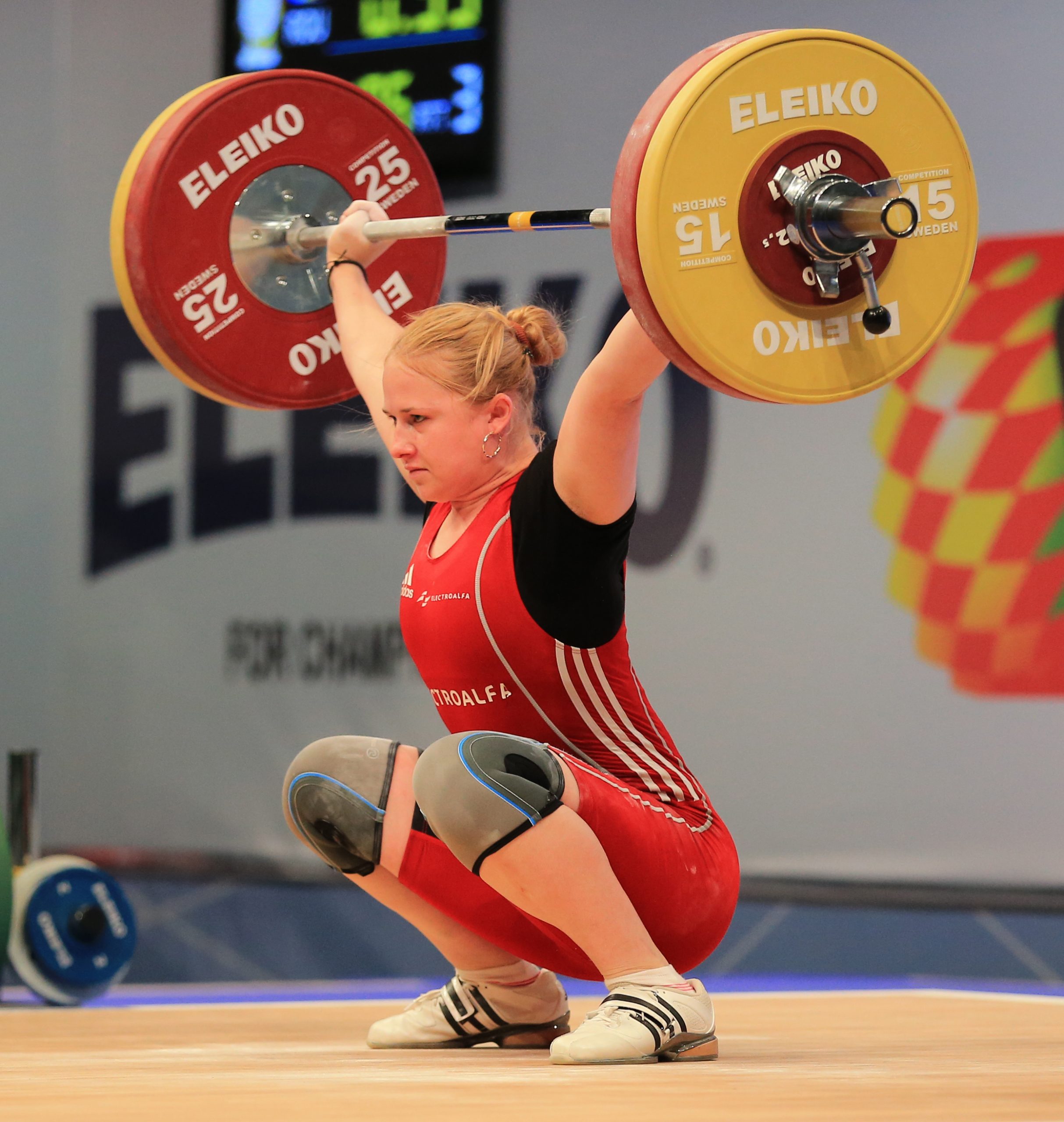Why Weightlifting Shoes?
Andrew Charniga, Jr.
Sportivny Press©
It is common knowledge that an athlete’s apparel varies according to the sport. This is especially true for shoes. In his book The Dialectics of Nature, the Marxist philosopher Engels observed the harmony between form and function in nature. The need for harmony between the form and function of the athletic shoe is absolutely imperative in sport.
For instance, in Track and Field, the design and function of the athlete’s shoes for each event vary according to the specifics of the activity. A distance runner would not wear a sprinter’s shoes for the 10,000 meter event and vice – versa; yet both are running events.
In many cases there is not a great deal of versatility in terms of what would appear to be similar athletic shoes. The spiked shoes designed for baseball are not appropriate for football even though both sports require a shoe that provides traction for running short distances.
So, it should come as no surprise that there is a special shoe made for weightlifting. The weightlifting shoe is rather unique in the world of sports because it features a raised heel. The form of the shoe has evolved over the 100+ years of international weightlifting competitions. Today the form of the top model of weightlifting shoe is in harmony with its function in the modern competition program.
The history of the design and the function of the modern weightlifting shoe is traceable in the history of the evolution of the technique of the weightlifting exercises.
The Evolution of Weightlifting Technique:
The Form and Function of the Modern Weightlifting Shoe Evolves
Two fundamental elements of weightlifting technique have had the greatest impact for the creation of a specialized weightlifting shoe. Ultimately, they were the driving forces behind the evolution in the design of the footwear: 1) the method by which the weightlifter moved his body under barbell; 2) the disposition of the weightlifter’s principle “kinematic links” (the trunk, thigh and shin) in the starting posture to lift the barbell.
Beginning in 1929, the International Weightlifting Federation reduced the competition protocol from five exercises to three. The new program consisted of one strength exercise, the press, and two speed strength exercises which are the snatch and the clean and jerk.
The press originally was intended to be a relatively simple test of the strength of the muscles of the arms and shoulder girdle. The snatch and clean jerk exercises, also known as the “quick lifts”, are exceptionally more complex. Essentially, the two “quick lifts” are a test of the explosive strength of the musculature of the lower extremities and trunk.
The method of lifting the barbell to the chest for the press did not require intricate technical elements (the early press was a very strict movement of the barbell from the chest to arms length overhead). Even a maximum weight for the press in the early days (pre 1950) was well within the strength of the weightlifter’s lifting muscles for the clean i.e., the legs, trunk, arms, and shoulder girdle. The weightlifter would typically lift the barbell to the chest with a small knee bend to receive it at the chest. So, in this exercise the “descent” under the barbell was minimal and required little technical proficiency. Likewise it required less “technique” to lift it from the floor to the chest.
The “descent” under the barbell for the snatch and the clean for the clean and jerk, on the other hand, is more complex because of the heavier the weight one attempts to lift, and, consequently, the greater the distance the lifter “drops” under the barbell.
The Descent Under the Barbell
The evolution of the “descent” under the barbell is connected with the effort to lower the trunk as far as possible. The ability to descend lower translated into bigger weights lifted in the snatch and the clean and jerk, i.e., the lower the “descent” under the barbell, the less height needed to lift the weight, the bigger the weight one could lift.
The weightlifter’s search for a low stable, positioning of the body under the barbell for the snatch and the clean and jerk meant bending the knee, ankle, and hip joints as much as possible in order to effectively lower the trunk as far as possible.
One early method of bending the lower extremities involved a slight knee bend and an asymmetrical shifting of the feet. It was called the “splot” (see figure).
|
Splot method of descending under barbell. F. Verkovsky, 1963 |
|
| Splot2 | |
The “splot” method of slightly bending both knees and shifting one foot backwards (so the athlete partially scissored the legs and squatted at the same time, hence the name) was made obsolete by the “split” style.
The “split” method involved shifting one foot forward in a straight line from its starting position and likewise the other foot rearward. A sufficiently large shifting of both feet into the “split” position lowers the trunk significantly further than the either a one quarter squat or a “splot”. Consequently, a weightlifter could expect to snatch and clean more weight with the “split style” of descending under the barbell.
However, in each of the aforementioned cases (1/4 knee bend, “splot” and split style), the weightlifter’s shoes did not have to be of a special design because the ankle joints were not called upon to bend significantly with the performance of these methods.
For instance, in the split style, the shin of the front foot typically would remain vertical in the lowest position; this helped maintain balance and kept the trunk in a vertical position. Lifters of the 20s and 40s and into the 50s wore sneakers. Many wore boxing shoes. Of the three main joints involved in lowering the weightlifter’s body (the ankle, knee, and hip), most of the bend in the split style came from the knee and hip joints.
Before going any further, one should point out the obvious to the non weightlifter that in order to snatch or clean a big weight by means of lowering the body under the bar, the lifter has to keep the trunk pretty much in a vertical disposition. It is all but impossible to hold a weight on the chest for a clean or overhead in a snatch with the trunk tilted significantly forward from the vertical. So, the flexing of the hip and knee in the split position and the disposition of the feet fore and aft has to be such that it allows the athlete to preserve a vertical position of the trunk.
R. Plukfelder (USSR). Photo European Weightlifting Federation. |
|
The above figure of a split clean shows the low position with a vertical trunk and relatively vertical shin of the front leg.
The weightlifter’s feet bend and straighten quickly in performing the weightlifting exercises. Some storage of elastic energy occurs. This is facilitated with flexible footwear. Furthermore, the weightlifter’s footwear needs to flex to perform the split style because the foot shifted backwards should rest on the ball of the foot and the toes with the heel raised off the floor (Figure 5 see rear foot). Conversely the front foot needs to rest flat on the floor. However, it is not too difficult to keep the front foot flat if the shin is vertical.
So, for the just described technique a boxing shoe or sneakers would suffice.
The Relevance of the Ankle Joint and Shin to Technique and the Design of Weightlifting Shoes
The appearance in the international arena of “splitters” John Davis (USA), Norbert Schemansky (USA), Rudolf Plukfelder (USSR) and Ireneusz Palinski (POL) demonstrated to the weightlifting world it was possible to lower the body to as maximum as possible by means of the “deep “split” position under the barbell. The lifter accomplished this by noticeably bending the ankle joint of the leg placed forward. This requires tilting the shin forward significantly away from the vertical. The lifter could descend lower under the barbell.
However, it was difficult to rest the front foot flat on the floor with the shin tilted way forward. (see figure of Plukfelder snatch) Nevertheless, the ankle joint has to bend (dorsiflex) significantly in order to effectively tilt the shin forward, and the lifter must flex the knee of the forward leg significantly to achieve the deepest position possible.
R. Plukfelder (USSR). European Weightlifting Federation picture. |
|
The picture above shows Soviet great Rudolph Plukfelder attempting to descend under the barbell in a snatch into a “deep split” position. Note the athlete is wearing sneakers and the heel of the front foot has raised which will cause a loss of balance.
With the advent of this technical innovation (the positioning of the feet in the “deepest” split position), weightlifters realized a shoe with a raised heel to allow the “flat footed” tilting of the shin was required. A shoe with a raised heel had to permit the back foot to flex so that the heel could be raised and at the same time the ankle joint of the front foot to bend.
The raised heel facilitates the “flat footed” bending of the ankle joint and at the same time a fuller activation of the muscles of the lower extremities. (see pictures of Lopatin)
S. Lopatin (USSR). European Weightlifting Federation picture. |
|
The picture of Lopatin in a deep split position shows a flat footed front foot and a significant tilting of the shin of the front leg. The higher heels of the Soviet shoes of this time permited this low position which would be precarious at best if attempted in sneakers or boxing shoes.
Weightlifters realized high laced boxing shoes or sneakers which were commonly worn up to the 50s were not appropriate for the just described “deep split” technique. You could flex your feet to raise your heels in the pulling part of the lifts and the rear heel in the split position, but there was no raised heel and the lacing inhibited the movement of the ankle joint if the athlete went to tilt the shin forward.
The Final Evolution of Weightlifting Technique: the Ankle Joint and Shin are the Keys
Another innovation in weightlifting technique of the late 40s and early 50s helped to transform the weightlifting shoe forever. This was the squat style. The George brothers (Pete and Jim, USA) are credited with convincing the weightlifting world that this technique of descending under the barbell was superior to all other methods.
The weightlifter simply moves his feet to the side and fully bends the knees, hips, and ankles to squat down under and “receive” the barbell at the chest for the clean or overhead for the snatch for the squat style technique. It was necessary (and difficult) to keep the front foot flat on the floor in the “deep split” style of descending under the barbell; however, it was absolutely imperative to rest both feet flat on the floor in the deep squat style technique. The weightlifter can lose balance very easily if the heels rise from the floor in the deep squat position.
A weightlifting shoe with a raised heel was actually more important for the squat style of lifting than it was for the “deep split” style, i.e., the area of balance is smaller in the squat position. A shoe with a raised heel allows the weightlifter to squat down with a reasonably vertical disposition of the trunk which requires fully bending the knees and tilting the shins forward; with the feet resting flat on the floor , i.e., the lowest, stable position to support the barbell became possible.
PAEK PRK. Charniga picture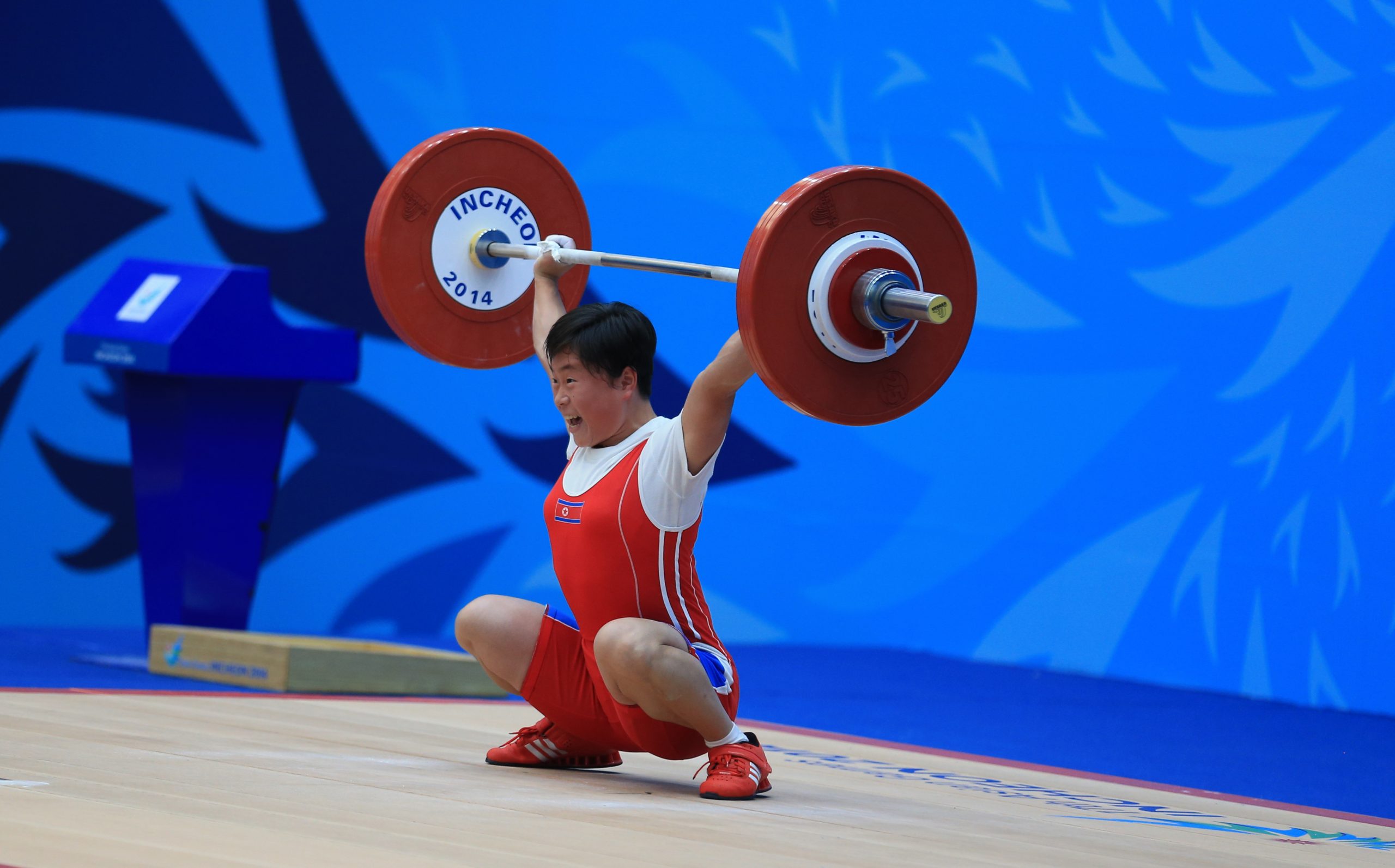 |
|
| Deep squat position |
|
The figure depicts the squat style technique with vertical trunk, fully flexed knees, hips and ankle joints. Note significant tilting of the shins which permits the lowest possible depth and improves mechanical leverage.
| Gulnoi Rattikan (THA). Charniga photo | |
 |
|
An erect positioning of the trunk in the squat is necessary for balance. An erect trunk during the descent is typical but not the only method of descending under the barbell. The weightlifting shoes with a raised heel facilitates the descent into and the maintenance of the squat position.
| Charniga photo | |
| Snatch with very low squat 2 | |
Depiction of squat style snatch with a relatively vertical trunk, fully flexed knees, hips and ankles and shins tilted well forward.
As the squat style began to catch on as the preferred technique, the search for appropriate shoes led lifters to try work boots and the like. These shoes (actually boots) had the raised heel but were also “high tops” in that the form of the shoes extended up past the ankle joint and were laced up past the aforementioned joint. These boots offered better stability than the boxing shoes or ordinary sneakers, but they still restricted ankle mobility. They were also generally stiff and heavy.
Furthermore, in the early years of the evolution of weightlifting technique from the split to the squat style, the significance of joint mobility as a means to facilitate lifting bigger weights was not as accepted it as it is today. So, lifters sought shoes with higher heels (more than 2.5 cm) so that they could squat down and maintain balance. However, the built up heels were a poor substitute for knee and hip mobility and, especially, ankle mobility.
V. Lukanin (RUS) Charniga photo. |
|
| ankle stretch with bar | |
A common exercise for ankle joint mobility of weightlifters involves stretching the muscles and tendons in the above depicted manner.
V. Lukanin (RUS) Charniga photo  |
|
Shoes with heels and ankle mobility cannot make up for an overall lack of mobility in shoulders and hips. The athlete pictured above should be able to perform this movement (even with an empty bar) with a more upright posture than is shown here.
Early manufactured versions of a specialty weightlifting shoe from the Soviet Union and Europe featured a high top design with little or no heel, but, eventually, a higher heel (upwards of 2.5 cm) emerged.
The fundamental flaw from the era with no specialty shoe persisted into the design of the specialty shoe, the “high top”, style shoe. These “weightlifting boots” (and this name persists to the present day) laced up past the ankle joint were assumed to provide support for the ankle joint. However, this type of shoe restricted, not facilitated, ankle mobility, especially concurrent with the bending of the knee; lo and behold, the ankle joints did not need support in the first place.
The Starting Position for the Lift from the Floor (the Pull), the Press, and the Jerk
As the technique of descending under the barbell evolved, weightlifters continued to search for more effective techniques of lifting the barbell as high as possible. This search found its expression in the starting position for lifting the barbell from the platform and in the starting position for the press and the jerk from the chest.
Weightlifters instinctively realized that in order to accelerate a moving object you need to increase the distance over which force is applied to it and, at the same, time use the body’s strongest muscles to the maximum.
In many cases, weightlifting’s old timers barely bent their knees in the starting position to lift the barbell from the platform. (see video of Schemansky). Consequently, the body’s strongest muscles (the extensors of the legs) were not fully utilized to raise the barbell. The extensors of the trunk and the flexors of the arms and shoulders did most of the work of raising the barbell to the chest or overhead in the snatch. It is obvious from the physiques of most of the lifters of that era which muscles bore the brunt of lifting the barbell.
However, lifters and coaches eventually came to the realization (with some assistance from a new sports scientist, the biomechanist) to lift the biggest weights you need to fully utilize the potential of the muscles of the lower extremities. The knees had to bend to a greater degree in the starting position of the pull phase of the snatch and the clean. This of course meant the shins should tilt forward with the bending of the knees, which, in turn, “pushed” the barbell forward away from the lifter in the starting position.
By beginning the lifts with more bending of the lower extremities, the best weightlifters could realize fully the strength of the body’s strongest muscles to lift the biggest weights. This “lower” starting position mechanically offered more possibilities. Some Asian lifters popularized a method of lifting which involved placing the heels together so that they could bend and, consequently, use their legs even more. It was known as the “frog style.”
Thongsuk (THA). Charniga photo. |
|
Starting position of the snatch depicting almost fully flexed knees, hips and ankles. Note significant forward tilt of the shins, which the athlete’s shoes with raised heels permits. The greater flexion in the lower extremities with this “low” start places a greater load on the these, the strongest muscles for weightlifting.
Fully utilizing the strength of the legs allowed the lifter to keep the arms straight for as long as possible before bringing these muscles into play during the lifts. The weightlifter was able to lift bigger weights than ever before with the combination of greater lifting efficiency from the strongest muscles and the ability to descend lower and more efficiently than ever before.
The jerk portion of the clean and jerk, and eventually the “Olympic Press” of the 60s and early 70s, required footwear to permit the lifter to bend flat footed. This flat footed bending of the lower extremities was facilitated by a shoe with a raised heel and an unrestricted ankle joint. Lifters who wore the “high top” Soviet made shoes did not bother to lace them up all the way (below the ankle joints) so that their shins could move unrestricted even though the movement of the ankle joint and shins during the half squat for the jerk and starting bend in the “Olympic Press” was rather small. (see photos of bottom of jerk and press slump).
V. Kolotov (USSR). T. Kono photo |
|
Depiction of the bending of the legs and trunk for the “olympic” press. Note the shins tilting forward and the “high top” Soviet shoes which have not been laced up past the cross strap.
Zhang Ping (CHN) Charniga photo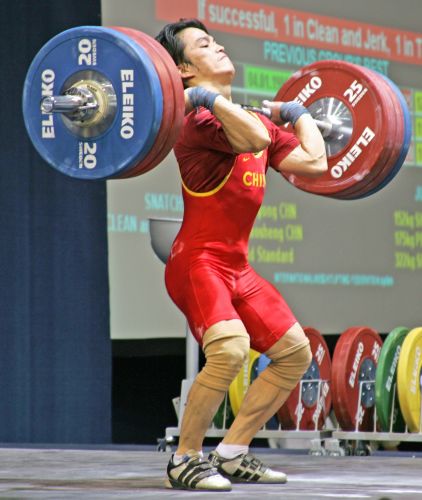 |
|
| Half squat for jerk. | |
Depiction of the half squat for the jerk. Note the modern lifting shoes with ankle joints “exposed”. The heels facilitate the tilting of the shins and the “exposed” ankle joints are free to bend without “artificial” restriction, both of which are necessary to generate the power to lift the barbell to arms length over head.
The need for a specialized weightlifting shoe and ultimately its form and function evolved along with the evolution of weightlifting technique. Early versions featured a “high top” shoe with very little heel. The designers of the early models of weightlifting shoes, assisted by input from coaches and athletes, assumed, apparently, that the ankle joints of the weightlifter needed to be supported. As already mentioned the laced up “high top” shoe restricted ankle movement and no raised heel or a very low heel did not facilitate ankle mobility sufficiently.
The Evolution in the Design of a Specialized Weightlifting Shoe
Of the early efforts to find a shoe for weightlifting such as a boxing shoe or a work boot, both types of shoes proved to be inadequate. One type (the boxing shoe) had no heel to facilitate ankle mobility, and ankle mobility was further restricted by the lacing over the joint. The other type (the work boot) had a heel which facilitated ankle movement, but the form of the shoe (called a “high top”) extended above the ankle joint. It was also stiff and heavy, both of which were counterproductive.
One of the early designs developed and manufactured specifically for weightlifting, featured the “high top” design, a very low heel, leather soles and heels (Russian model). Typically, the heels were fastened to the shoe with nails.
The first specialized shoes for weightlifting incorporated two features found in the types of shoes weightlifters tried when there were no specialized shoes for weightlifting, a “high top” and a heel. The raised heel was designed for ankle mobility and (flat footed) balance, and, the perceived necessity of “supporting” the ankle joint with a “high top” carried over into the design of the first specialized weightlifting shoes.
It is appropriate to point out during this discussion of the design of the specialized weightlifting shoe, the following fact: ankle joint injuries, per se, are virtually unknown in weightlifting. (See addendum Weightlifting Injuries)
Eventually the “high top” design was displaced by the modern “low cut” shoe. The designers of the “low cut” made no effort to “artificially” support ankle movement. Anyways, lifters had long since quit lacing the high top models past the ankle joint.
The Soviet made shoes with “leather heels, soles and nails” were ultimately displaced with the introduction of wood heels and crepe soles. The Soviet design was not just flawed but dangerous. The use of resin on the sole of the shoes by the weightlifter, especially before stepping onto the competition platform, in all probability was due to the propensity for weightlifters to slip and slide (especially while scissoring the legs under the barbell) in their Soviet made weightlifting shoes. (see picture)
V. Kanygin (USSR) Photo by T. Kono |
|
| Kanygin Slipping | |
The leather soles and heels of the Soviet made weightlifting shoes predisposed the lifter to slip or otherwise slide on the wood surface of the weightlifting platform. If the head of the nails fastening the heels were exposed the risk of slipping was even greater not to mention the possibility of an exposed nail “catching” a crack in the surface of the platform.
Without question, the principal attraction to the Soviet style shoes within the weightlifting community had virtually every thing to do with the fact the Soviets were the best lifters; the best lifters wore those shoes, and this had nothing to do with any advantages offered by its design.
Adidas of Germany has been the world’s only true designer/manufacturer of weightlifting shoes for more than 40 years. The evolution of the Adidas design reflects some of the Soviet influence. The early Adidas models featured a “high top” and their roots in sneakers, i.e., the shoes had rubber soles with very low heels. Furthermore, over the years Adidas has spent considerable the time and effort to work hand in hand with the weightlifters and coaches to develop and improve the design of the shoe. (see Tommy Kono’s meeting with Adi Dassler in addendum #2)
Even the Soviets eventually abandoned their arguably dangerous design and introduced a low cut shoe. Soviet weightlifters wearing the “high top” model began the “creative destruction” of the design long before the introduction of a Soviet made low cut by not lacing the “high top” shoes above the ankle joint (see pictures). The lifters and the coaches realized a laced up “high top” shoe was a hindrance to effective weightlifting technique.
D. Rigert (USSR) Photo T. Kono |
|
S. Lopatin (USSR) European Weightlifting Federation photo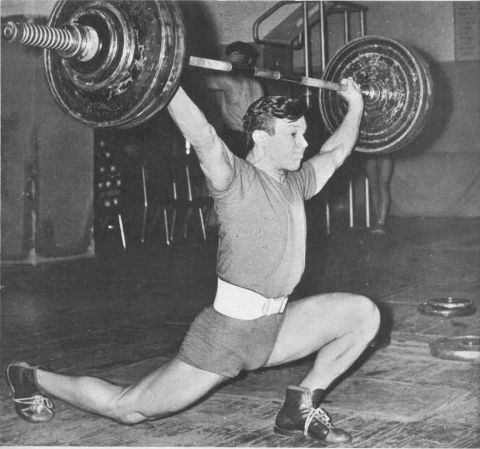 |
|
| Lopatin Snatch with old shoes | |
Soviet lifter wearing early models of the Soviet made weightlifting shoes. Note: the “deep split” position.
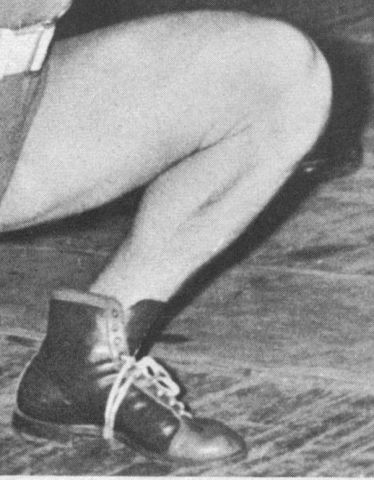 |
|
| Lopatin’s shin and shoe | |
This close up of the picture above reveals the shoes have not been laced up all the way and the athlete has fashioned a rudimentary “tarsal strap” by running the lacing underneath the shoes. Notice also the moderate heel and the significant tilting of the shin.
The Adidas models, redesigned/refined every four years now, reflect the current state of the art in the long search for harmony between the form and function of the specialized weightlifting shoe: a “low cut” design, a fixed height wood heel, flexible crepe sole, upper portion of leather and synthetic construction.
Conclusions
The modern weightlifting shoe, designed without leather soles, nails fastening the heels to the shoe and no artificial “laced support” of the ankle joint, allows the foot and ankle joint to bend and straighten without artificial restraint, along with the knee and hip joint. And, despite this “lack of support” from the shoes and arguably the greatest stress placed on the ankle joints and the fifty two bones which make up the feet in all of sport, injuries to the weightlifter’s ankle joints and feet are rare.
The search for a shoe for weightlifting and the ultimate design of a specialized shoe which emerged can be traced to the gradual evolution of weightlifting technique and the accompanying gradual realization among weightlifters, coaches, sport scientists, and shoe manufacturers that the body’s strongest muscles are in the lower extremities. These joints need to bend and straighten freely and through as large an amplitude as possible in order to fully realize the potential of the human body to lift maximum weights in weightlifting.
The efforts to find a weightlifting shoe (off the store shelf) and, later on, in the early designs of a specialized shoe proved to be misguided by false assumptions, since the ankle joint need not be “protected” by a “high top” shoe. Eventually it became widely recognized that a heel of some moderate height was necessary, but a heavy work type shoe with a built up heel was not; nails fastening a leather heel of the shoe and leather soles proved to be dangerous.
D. Rigert (USSR) Photo T. Kono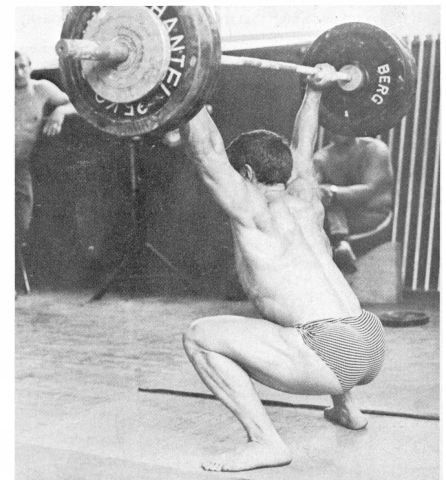 |
|
| Rigeret Bare foot snatch | |
The above photo of David Rigert (one of the greatest lifters in weightlifting history) shows him “playing” around in the gym, snatching a 130 kg barbell in his bare feet, the day after winning the European Weightlifting Championships. Rigert wore Soviet style weightlifting shoes in the competition the day before.
Addendum # 1
Weightlifting Injuries and the Specialized Weightlifting Shoe
According to A. N. Vorobeyev and others (1,2) the most common injury in weightlifting is a back injury. Lumbar pain, and or, injury to the inter vertebral discs of the spine (especially in the lumbar area) are connected primarily with two exercises, the back squat and the clean pull. The reason these two exercises are most likely the culprit of back pain, or a back injury, is because the weightlifter lifts the biggest weights in these exercises.
The second most common injury in weightlifting is a shoulder injury, and with the introduction of the biathlon program after the elimination of the press, elbow injuries have become more commonplace.
What about ankle injuries? According to Vorobeyev (1) ankles can be injured in weightlifting if the nails on the bottom of the weightlifting shoes (fastening the heel of the Russian models) are “protruding and catch on the platform when the lifter moves the feet during the lifting,” likewise, (2) if the lifter’s shoes “catch” on ruts, splinters, or nails protruding in the weightlifting platform. Furthermore, the weightlifter can be injured (ankles included) by slipping if resin is not applied to the leather sole of the shoes (Russian design).
Therefore, according to the Soviet experts, ankle injuries in weightlifting are connected principally with the early (Soviet) design of the specialized weightlifting shoe itself and not the actual stress on these joints from lifting a barbell. The production of the Soviet designed weightlifting shoe which consisted of a “high top” with leather soles and heels fastened with nails persisted into the 1980s.
Considering the fact that the design of the specialized shoe itself was the culprit in the few ankle injuries reported in weightlifting, it, is curious to say the least, when you take into account the colossal loading these joints are subject to the act of lifting.
It is common knowledge that the weightlifter literally jumps from the floor in the descent phase of the weightlifting exercises, i.e., both feet are raised from the floor at the same time, or one after the other.
A. Kolokolsev (UKR) Charniga photo |
|
Superheavyweight lifter “jumping from” the platform to descend under a light weight.
For instance, a select few weightlifters have lifted more than three times bodyweight in the clean and jerk. The weightlifter first cleans the weight and, in so doing, lifts both feet from the floor and “actively” returns them to the platform along with the barbell, i.e., the ankle joints sustain almost four times the weight of the weightlifter’s body plus the acceleration of gravity and the additional force of the weightlifter “forcefully reestablishing” his base of support. This same process is repeated in the second half of the exercise when the weightlifter first “tears” his feet from the platform and likewise explosively returns them to the platform in the jerk, one at a time.
A. Klescznovskaya (POL) Charniga photo |
|
| Jerk both feet in air | |
The weightlifter jumps away from the platform in the jerk and returns the feet forcefully to the platform in a fraction of a second, subjecting the lower extremities to a massive loading.
So, the stress on the weightlifter’s ankle joints, relatively speaking, is enormous. And yet, ankle joint injuries are virtually unheard of in weightlifting despite the fact that the weightlifter’s ankles are subjected to what is, arguably, the most stress on these joints to be found in all of sport.
Addendum # 2
Tommy Kono’s Meeting with Adi Dassler
At the time this meeting took place Tommy Kono (USA), the two time Olympic Champion, Olympic silver medallist, and eight time world champion, was the national weightlifting coach of West Germany. Kono was well known in Europe even before his tenure as national coach, as most of his titles were won on the continent of Europe.
Adi Dassler was the founder of the Adidas company which still bears a combination of first and last name.(Ed)
“I don’t know if I ever told you or Bud the story of my meeting with Adi Dassler back in either 1970 or 1971. Because I had sat in for a couple of hours signing autographs at one of the large department stores in Manheim (they had a life size picture of me in their display window announcing the “autograph” hours). I was given a couple of kids” bikes (my daughter and son) and a pair of shoes. It was Adidas’ first try at copying the Finn’s Karhu lifting shoes.
I noted that the strap was too high on the shoes and it restricted the ankle movement. I wrote to the Adidas firm with a drawing to go with it to correct it. They wrote back an appreciative letter and followed up by sending me another pair of their shoes with the straps lower but not low enough.
Anyway, when I wrote another letter explaining it was much improved but still not correct, they phoned me and asked if I might drop over to their factory outside Nurnberg.
One Saturday morning I was free so I drove to their factory with both pairs of shoes. The staff at the factory were extremely nice to me, showed me around, and I had lunch with Mr. Adi Dassler. I left the two pairs of shoes with them with a promise from them that they will correct it and send me a new pair that should be to my satisfaction. And, in parting they gave me a check for $200.00 (in Deutsch mark) for my time. This was totally unexpected but extremely professional of them. As the National Coach, I wanted to be certain that I could help the sport from every angle.
L. Espinosa photo. |
|
Adidas model weightlifting shoes circa 1972 of the type with “high top” design and low rubber heel.
Addendum # 3
The Technical Rules of the International Weightlifting Federation Regarding Weightlifting Footwear
In light of what has been said about the evolution of the specialized weightlifting shoe, it is of interesting to review the technical rules regarding its use and design.
First, the rules (3) stipulate that “competitors must wear sport footwear (called weightlifting shoes, boots) to protect their feet and to give them stability and a firm stance on the platform.” The obvious inference here is that the specialized weightlifting shoe performs such a special function that the wearing of weightlifting shoes in competition is mandatory for safety.
Second, according to the rules the design of the shoes must be such that they “do not give the athlete an unfair advantage or additional support.” How a special design would offer an unfair advantage is not specified.
Third, several rules are out of date or simply do not take into account how the shoe evolved in the first place.
For instance, the Adidas shoe has three straps crossing the instep down to the toes. The rules specify that a single strap is permitted.
The rules state, “The maximum height permitted on the upper part of the footwear measured from the top of the sole, is 130 mm” i.e., the height of the shoe covering the ankle joint is restricted. Well, the manufacturers, athletes, and coaches had already decided that a “high top” shoe was inappropriate for weightlifting and the “high top” design has pretty much long since disappeared, so the rule is moot.
The necessity of free movement of joints in weightlifting can be inferred from the rule 4.4.5 on the length of the bandages allowed over the knees and wrist. There is no length restriction, i.e., more bandage means less joint movement or at least slowing the speed of movement. In either case, unlike powerlifting, “extra” support is a hindrance in weightlifting.
References
1. Vorobeyev, A.N., Weightlifting, Textbook for the Institutes of Sport, FiS, Moscow, 1988. English Translation: www.sportivnypress.com Translated by Andrew Charniga, Jr.
2. Geselyevitch, V.A., Medical Reference Book for the Coach, FiS, Moscow, 1988. Translated by Andrew Charniga, Jr.
3. Hand Book of the International Weightlifting Federation 2005 – 2008. Editor Dr. Tamas Ajan. Published by the International Weightlifting Federation.
4. Kono, T., Personal Communication
